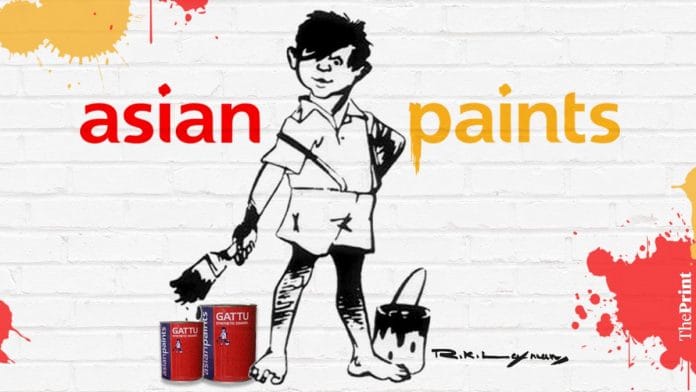There are some brands that become household names because of a tag line, some because of a catchy song, and maybe a few because of the actual product. And then there are brands that get their name and fame because of their mascot. Case in point: Gattu, the mascot created by renowned cartoonist R.K. Laxman for a then small company called Asian Paints that was born in a garage in the 1940s and had yet to make it big.
The mascot was conceived in 1954. The story goes that R.K. Laxman was chain-smoking and searching for inspiration for an idea for the Asian Paints mascot. Then “…through the cloud of smoke he saw the image of a little boy with a paintbrush take shape, and ‘Gattu’ mascot was born.”
The mascot finally had a shape but it still did not have a name. A ‘Give Me A Name’ contest was organised with a prize money of Rs 500. Around 47,000 entries were received for the contest, and the winning name, Gattu, was suggested by two people, both from Bombay, who shared the prize money equally.
Gattu was seen in many forms over the decades, initially as a mischievous boy, a brat who would not be stopped from painting, even when he wasn’t supposed to and even on things he shouldn’t paint on, such as, in a famous advertisement, a man’s bald head. The tag line accompanying him, ‘Any surface that needs painting needs Asian Paints’, remained unchanged. And it made the brand extremely popular. Vipul Prakash, who was a brand manager with Asian Paints in the ’90s, called him “a very powerful asset especially in rural markets”.
Even after Asian Paints had moved to ad agency Ogilvy, Gattu and his paintbrush remained an inseparable part of the brand’s identity. No matter what the ad campaign was, Gattu was always present, even if in a small corner.
Piyush Pandey, the name behind some of India’s most famous campaigns, including Doordarshan’s Mile Sur Mera Tumhara and the BJP’s Achhe Din campaign for the 2014 Lok Sabha elections, had also worked with Asian Paints as part of leading advertising agency Ogilvy.
He acknowledges that Gattu did a great job for Asian Paints, adding, “Our campaigns were mainly focused on Indian families and celebrations during festivals, during which people usually paint their houses.” That also helped to make Asian Paints a brand that people associated with home, togetherness and love — particularly campaigns like Har Ghar Kuch Kehta Hai.
He tells ThePrint, “I had joined Ogilvy in 1982 and started working with Asian Paints in 1984. The literacy rate during that era was comparatively less. People would recognise a brand by its mascot — whether it was Gattu or any other mascot.”
Also read: The Rasna girl who stole hearts one ’80s ad at a time
Time came to let go of Gattu
However, even the best ideas sometimes come with a shelf life. And in the 1990s, Ogilvy finally summoned the courage to tell Asian Paints that Gattu needed to go.
Pandey recalls, “I was a part of the team that decided to replace Gattu with the Asian Paints logo. Although Gattu was a mass mascot, the brand needed something universal.” It was also the time to scale up to a more premium vibe, especially post-economic reforms and the opening up of the Indian markets.
Also, says Pandey, “Gattu became equivalent to Asian Paints. The brand was being recognised by the mascot more. It couldn’t have twin identities and they did not want to lose the brand.”
“We all questioned the decision at the time, but now feel it was right. And finally, while it did a great job of extending into adjacencies, Asian Paints never dropped its focus on the core offering,” said Prakash, currently the Senior VP – Beverage Category at PepsiCo India.
The mascot was finally done away with in 2002 and it was replaced by the brand’s current logo. Many thought that the brand was making a mistake by dropping a part of its identity, but the once paint-can company, now a household finishing behemoth, has thrived.
Still, it hasn’t forgotten where it came from, and who helped it along the way. When R.K. Laxman passed away in 2015, Asian Paints paid tribute to the legendary cartoonist with a poster featuring Gattu in the frame.
Also read: Cricket Samrat, the magazine that religiously spread the gospel of cricket for 42 years






